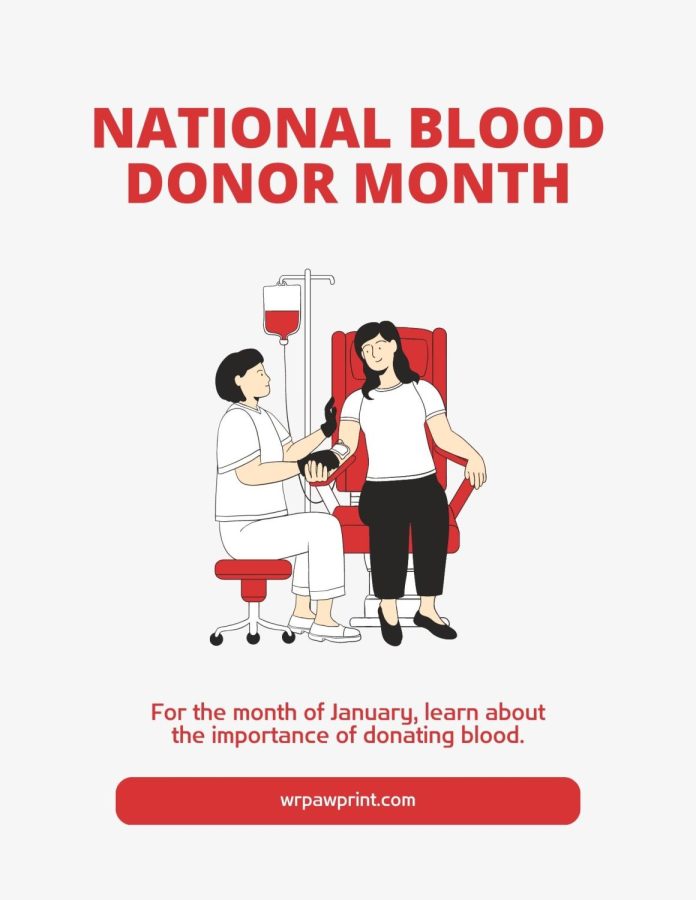National Blood Donor Month
February 7, 2023
According to the American Red Cross, we are facing a national blood crisis in which extreme blood shortages have left storerooms empty, patients waiting and healthcare compromised. In light of January being National Blood Donor Month, it is important to draw attention to the constant demand for blood and take proper actions to ensure that our current blood crisis—the worst we’ve dealt with in over a decade—comes to an end.
Robert Woodall, the American Red Cross’s Manager of Biomedical Services for Antelope Valley and Santa Clarita explained that “Every day, our area hospitals like Henry Mayo Newhall, Providence, Kaiser, Palmdale Regional and Antelope Valley Medical Center, UCLA and many more use 300 units of blood for trauma, surgery, childbirth and ICU. Blood donation is an essential service and the only way we get it is from volunteer donors—generous life-savers who want to help others in need.”
West Ranch athletic director Mr. Livermont, a frequent blood donor, discussed his motivation for donating blood. “Just knowing that it’s going to a good cause, and that it could be lifesaving for whoever receives it. Knowing that I can make a difference in a small way for somebody else who is in need, I might as well do it.”
Although technology continues to grow and adapt, there is no artificial replacement for blood and the only way to keep up with the constant supply for blood is to mobilize volunteers to donate. Recently, West Ranch took steps to mobilize its students by partnering up with UCLA to host a blood drive.
For West Ranch senior Carys Hay, it was “the idea of helping someone in need” that pushed her to donate at the blood drive. “My body makes [blood], and if someone needs it really badly, then there’s nothing that would make me feel more fulfilled, and I think that’s what motivates the majority of people who do it.”
Mrs. Ferry, a counselor at West Ranch, also decided to give blood at the UCLA drive. “My hope is to make a little difference for someone who is injured in an accident, undergoing cancer treatment, or battling a disease. Basically donating blood can save lives.”
Each blood donation has more than one use. Depending on what ailment the blood is going towards, processors are able to pick out certain components and use different parts. In this way, donors are not only able to provide hospitals and patients with more than one supply of blood and nutrients, but donors are also able to save more than one life.
Most people are aware of the importance of blood in healthcare, but many aren’t aware of the true extent that one donation can make. Mr. Smith, the AP Biology teacher at West Ranch, described how “for individuals with hemophilia, they’ll take blood from multiple donors and they’ll remove the clotting proteins, so that every four to six weeks, they can give these hemophiliacs the clotting proteins so they don’t bleed to death if they get an injury. And then also they separate the blood cells from the blood, so that you have plasma, as well as the solid components: the erythrocytes, the leukocytes, the platelets and so forth. And they can use those for different needs.”
The donation process itself is easy. Donors must be at least 16 years of age and meet the requirements of being at least 110 pounds and 5’4” in height. Mr. Woodall explained that after acquiring parental permission, “you’ll go through a health screening for about 15 minutes, where they take your blood pressure, temperature, heart rate and hemoglobin (iron) to make sure you are healthy to donate.”
For healthy donors, the amount of blood donated, including the red blood cells, platelets and plasma, is replaced overnight. After one has been approved for donation, a nurse or technician will insert a needle into the proper vein and begin drawing blood. The process doesn’t take more than 35 minutes, and it’s very doable even for those who are scared of needles.
Mr. Livermont described the process of donating. “I’m personally scared of needles myself, so for me when I lay down, I’m a little nervous, but the needle goes in, I make sure I turn my head when they do it, and then they cover it up and tape it up. It’s fun to actually watch the cycle and see how the blood’s going through the machine.”
Blood donation is crucial to sustaining our hospitals and preserving human life. To commemorate this year’s Blood Donor Month, encourage others to donate blood and try it out yourself. Although it might seem intimidating, try it once and remember that the blood is going towards a great cause. Like Mr. Smith stated, “You’ve got up to twelve pints, go ahead and give one. Blood is the fluid of life: share it.”


